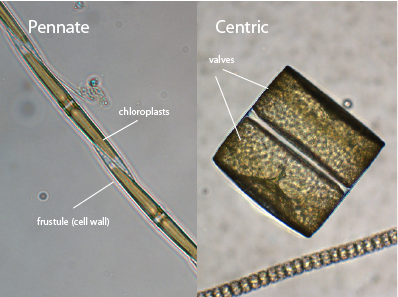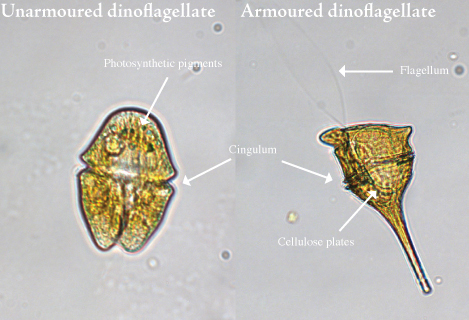Diatoms and Dinoflagellates
There are many different groups of phytoplankton species found in the world's oceans, but among the most common are diatoms and dinoflagellates. Most of the species featured on this site belong to one of these two groups. There are several features of a phytoplankton cell that can identify it as a diatom or dinoflagellate.
 
|
Diatoms
- Eukaryotic single-celled algae
- Divided into two major groups based on the structure and shape of the valves. These are the Centrics (Order: Biddulphiales) and the Pennates (Order: Bacillariales)
- They are most like plants in their ability to meet their nutritional needs through photosynthesis
- The presence of chlorophyll and accessory pigments, especially fucoxanthin, give them a golden color and serve to harvest light energy from the sun
- Cells are encased in a transparent glass-like silica “container” called a frustule that resembles a petri-dish. The overlapping valve is called an epitheca and the lower valve is a hypotheca
- The frustules can be ornate and very beautiful, and due to the resistance of silica, they form an important part of the fossil record
- Cells may form chains or colonies.
- Up to 100,000 species of diatoms have been recorded world-wide
|
Dinoflagellates
- Eukaryotic single-celled algae
- Many have two flagella, which allow the cells to have limited mobility
- Cells are covered by a theca (sheath) that can be smooth or ornamented
- Some species are able to migrate vertically through the water column, seeking nutrients, prey, or protection from harmful UV rays.
- Nearly half of known species are capable of photosynthesis and contain light-harvesting pigments (autotrophs)
- Some species survive by other nutritional modes, and may absorb organic matter or engulf prey (heterotrophs)
- Many species employ a combination of autotrophic and heterotrophic behaviors
- Of the 2000 known species, about 60 are able to produce complex toxins
- Dinoflagellates are a very successful group, at times to the detriment of the ecosystem. When conditions are favorable, a population explosion or bloom may occur, sometimes resulting in contamination of fish and shellfish and posing a threat to human and animal health.
|
